|
The waterways of Mammoth Cave National Park provide habitats and resources for a wide variety of species to prosper. Both the aboveground and underground rivers in the park are home to fish, including two species of rare cave-dwelling eyeless fish. In the CaveThe rainwater that seeps in through the sinkholes of the karst system of Western Kentucky drains to the deepest levels of Mammoth Cave, helping sustain the delicate ecosystems that provide shelter and food for several aquatic species including blind cave fish. These fish, also known as eyeless fish, have adapted to lightless, low-energy environments by ceasing to grow eye structures and unnecessary skin pigments. These fish are troglobites, meaning they spend their entire life cycles in the cave. The southern and northern cave fish are inhabitants of Mammoth Cave, these two species differ minutely in size and structure. For centuries, their lives have puzzled and intrigued scientists. Their survival depends on the quality of surface and groundwater that makes its way into the cave; human activities and interactions with our natural resources make an impact on Mammoth Cave’s subterranean species. 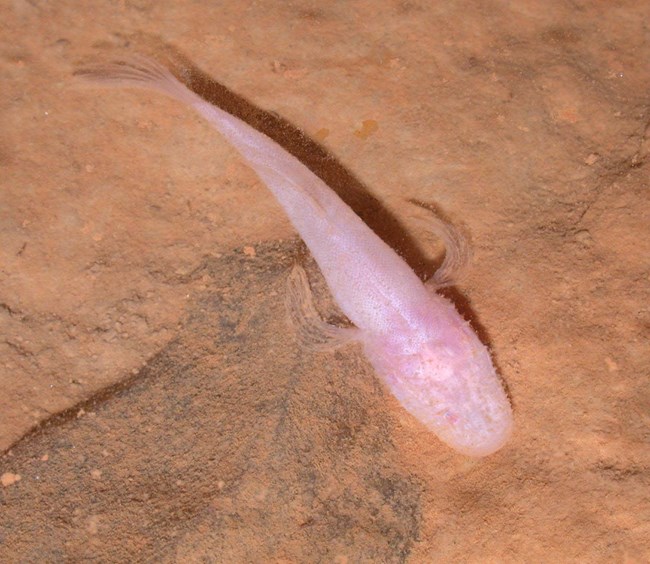
NPS Photo/ Rick Olson Cavefish SpeciesNorthern Cavefish Amblyopsis spelaeaDescribed in the early 1820s, the northern cavefish was first discovered in the rivers of Mammoth Cave. Early biological observations of these cavefish were first published in the book An Excursion to the Mammoth Cave, and the Barrons of Kentucky by Robert Davidson (1840). This inspired other researchers to study the internal anatomy of this species to understand more about their development and evolution. They are only found in Southern Indiana and North Central Kentucky and are not found north of the East Fork of White River, Indiana, or west of Mammoth Cave. 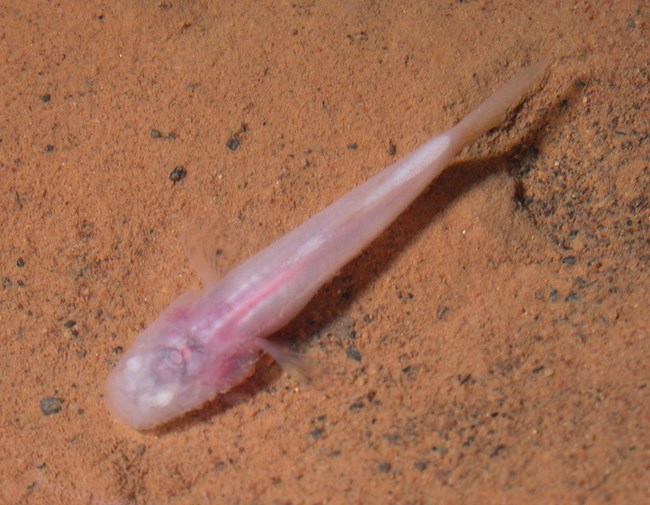
NPS Photo/ Rick Olson Southern Cavefish Typhlichthys subterraneousDescribed in 1859 by C.F Girard, the southern cave fish was discovered in a well near Bowling Green, Kentucky. Eyeless and unpigmented, these fish are found only in two areas of the world. The first area is the Ozark region of Missouri, Oklahoma, and Arkansas, and the second is in parts of Alabama, Tennessee, and Kentucky. With broad, large heads and hidden rudimentary eyes, they have adapted to survive in a lightless environment. Tests have shown that coloration occurs if they are taken to the surface and exposed to light. Their body, head, and caudal fin is covered by sensory papillae which allows them to navigate subterranean environments in the hunt for food. Their diet consists primarily of tiny freshwater crustaceans called copepods and isopods. 
NPS Photo/ Tegan Sorensen A Shared EnvironmentMammoth Cave National Park is one of the few sites in the world with both northern and southern cavefish. Due to the isolated nature of a cave system, typically only one species is found. However, the occurrence of both fish species is due to interconnected karst topography and flooding. Northern and southern cavefish are able to coexist in areas where the habitat is significantly diverse to allow habitat segregation. Southern cavefish inhabit master drains of vertical shafts, while northern cavefish are found in deeper water with less food availability further downstream. It is unknown why these species do not intermingle; it is hypothesized that food supply, competitive dominance, or aggression between species may limit interactions. Importance of Water QualityAquatic cave life is especially vulnerable to groundwater pollution from fecal contamination, feedlots, grazing pastures, fertilizers, pesticides, road salting, and other surface materials. Harmful particles can stick to sand and silt particles, which may settle in cave depths. Pollution, flooding of reservoirs, cave vandalism, and construction also have lasting impacts on cavefish habitat and livelihood. In an effort to protect groundwater and cave stream habitat, federal, state and private partners work together to regulate land and waterways within the Mammoth Cave Biosphere Region. On the SurfaceThe rivers of Mammoth Cave National Park are home to over 80 species of fish in 18 different families, including darters, shiners, minnows, gar, bass, and crappie. Most of these species are native to the area with a few exceptions such as the common carp. A few fish species found in the park are considered imperiled in Kentucky and other states, these species include the popeye shiner, western sand darter, and the spotted darter. Interesting Fish Species from the Surface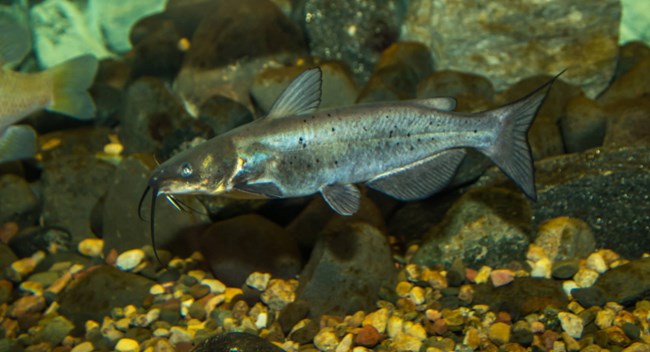
USFWS Photo/ Brett Billings CatfishThe park has two species of catfish, the channel catfish Ictalurus punctatus and the flathead catfish Pylodictis olivaris. The channel catfish is the most numerous catfish species in North America, having distributions from Canada to Mexico. They are cavity nesters, laying their eggs in crevices, hollows, or debris, to protect them from swift currents. 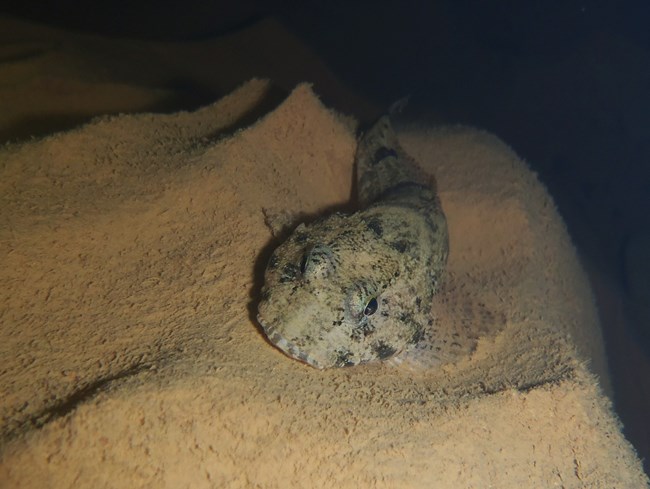
NPS Photo/ Rick Olson banded sculpin Cottus carolinaeThe banded sculpin is a bottom dwelling fish that resides in small, fast-moving streams. Young sculpins tend to be found more often in smaller pool and riffles, while adults tend to spend more time in deeper water, The coloration and stripping pattern on the sculpin protects the fish from predation by camouflaging it into its surrounding. Sculpin are predominantly ambush hunters who mostly feed on small insects and insect larvae, but are also opportunistic feeders, feeding on plant material, other fish, and even the occasional salamander. 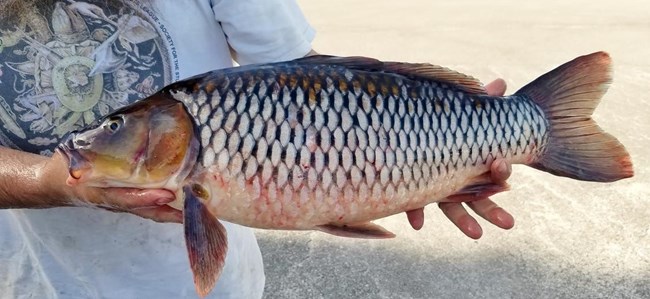
USGS Photo/ Kaitlin Kovacs common carp Cyprinus carpioThe common carp is a non-native species, originally from Europe and Asia where these omnivores often prefer to scavenge river and lake bottoms for aquatic plants, crustaceans, and insects. In 1877, due to public pressure and the overfishing of other species, the U.S. Commission of Fish and Fisheries began introducing the common carp into the wild. Carp populations quickly grew as they were able to outcompete some native species, helped by the fact that carp are highly tolerant of polluted waters. Other more harmful species of carp such as the bighead carp and silver carp, often referred to as Asian carp, have not been found in the park. Fishing in the ParkFishing in park waters is allowed. Anglers must follow all National Park Service and State of Kentucky regulations. More information about fishing in the park, including regulatory information, is available. |
Last updated: November 19, 2021
